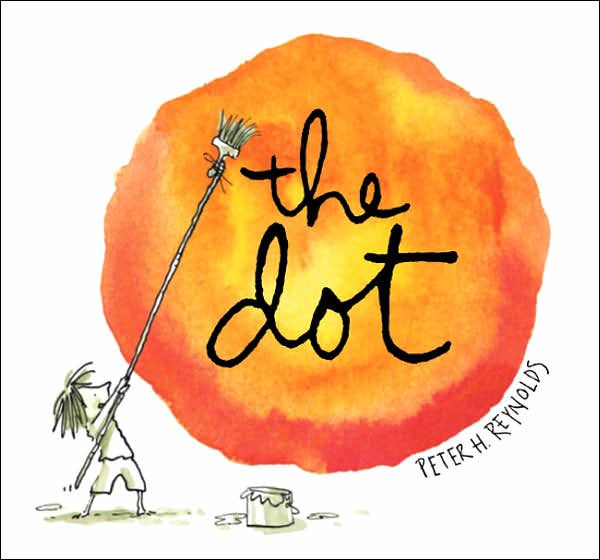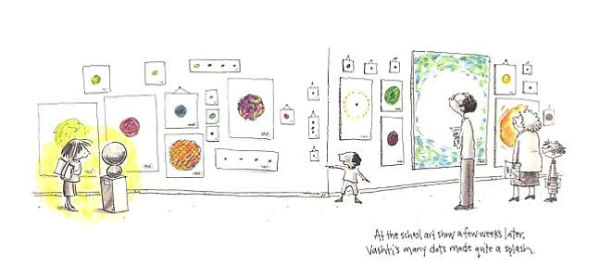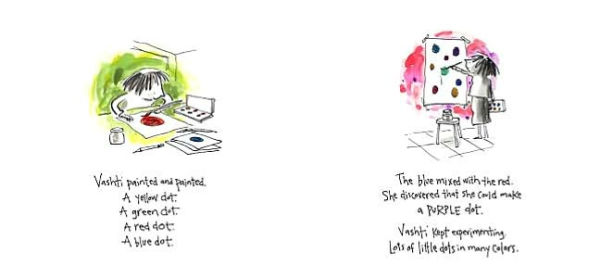In this engaging, inspiring tale, Reynolds (illustrator of the Judy Moody series) demonstrates the power of a little encouragement. . . . Reynolds pulls off exactly what his young heroine does, creating an impressive work from deceptively simple beginnings.
—Publishers Weekly (starred review)
With art that seems perfectly suited to the mood and the message of the text, Reynolds inspires with a gentle and generous mantra: 'Just make a mark.'
—School Library Journal (starred review)
Simplicity itself, like the dot in the title, this small book carries a big message.
—Booklist (starred review)
A fable about the creative spirit in every child.
—Nick Jr. Family Magazine Best Books of the Year
This small gem of a book tells the story of Vashti. . . . It's the beginning of a love affair with dots in many different colors, sizes and patterns — and a marvelous lesson about what art is.
—Washington Post
Readers can wonder about unsigned works that lie before us all.
—Chicago Tribune
In other hands this story about the power of the creative spirit could be preachy and overdone, but Reynolds keeps the voice fresh and the message subtle.
—Book Links
A wise and delightful tale for all ages.
—Yellow Brick Road
Reynolds' pictures in this parable . . . emphasize that all art, from the most impressive masterpiece to a child's simple scrawl begins the same way and by definition there is no right or wrong way to express oneself — an important lesson for anyone who is learning something new.
—Syndicated Column - Lynne Burke
This is a charming fable about faith and art. Reynolds's drawings have just the right lightness and whimsy to keep it all afloat in a cartoony watercolor-washed world.
—Boston Globe
This small gem of a book tells the story of Vashti...and a marvelous lesson about what art is.—Elizabeth Ward
In this engaging, inspiring tale, Reynolds (illustrator of the Judy Moody series) demonstrates the power of a little encouragement. Minimal narrative and art elucidate the plight of Vashti, who sulks next to her blank paper at the end of art class: "I just can't draw!" The art teacher sagely responds, "Just make a mark and see where it takes you." The scowling girl takes a marker and jabs at her paper, making a minuscule dot. The teacher "pushed the paper toward Vashti and quietly said, `Now sign it.' " When Vashti returns the following week, her signed picture hangs in a gilded frame over her art teacher's desk, which inspires the budding painter to greater feats. A later spread, guaranteed to evoke smiles, reveals an extensive display of Vashti's dot paintings (and even a similarly themed sculpture) at the school art show, where a boy praises her for being "a really great artist." When he insists that he can't draw, she emulates her art teacher's example. Rendered in watercolor, ink and tea, Reynolds's spare, wispy illustrations exude a fresh, childlike quality pleasingly in sync with his hand-lettered text. Offering a rare balance of subtlety and hyperbole, this small-format volume should give reticent young artists a boost of confidence-and encourage spontaneity in their artistic expression. Reynolds pulls off exactly what his young heroine does, creating an impressive work from deceptively simple beginnings. Ages 5-up. (Oct.) Copyright 2003 Reed Business Information.
Here is a short, simple book that says so much. Vashti sits with a blank piece of paper in art class and says, "I just can't draw." The teacher asks her to "make a mark and see where it takes you." Vashti jabs the paper and makes a dot; her teacher asks her to sign it. The next day, Vashti sees her dot "All framed in swirly gold!" From there Vashti explores her creativity (which is not how our children will put it, they will just say, "she's making a lot of pretty dots." Reynolds inspires others and finishes with an "aww" ending that just makes you want to hug the book. This is NOT a treacly message book, it is a sweet, accessible story that resonates for all ages. 2003, Candlewick Press, Ages 5 to 8.
— Sharon Levin
K-Gr 3-This is a dual-text version of a story of a little girl who emphatically states that she can't draw. Her wise teacher tells her to "Just make a mark and see where it takes you." After Vashi jabs a dot on her paper, the teacher urges her to then sign it. The next day Vashi arrives at school to find that it has been framed and hung. She is encouraged to create more watercolor dot paintings, and they are subsequently displayed in an art show. When a boy admires her work, she, in turn, encourages his efforts. The braille translation is accurate but the weight of the heavy board-book pages has caused the raised dots to be mashed down in places. This lack of uniformity makes it more difficult for braille readers to decipher. The book includes a glossary with an explanation of the contractions that appear in bold text in the book. The glossary itself isn't brailled, but perhaps it's not necessary, since the book is for more advanced readers. Unfortunately, only the text is translated into braille, so the impact of Reynolds's colorful, free-spirited watercolor illustrations, particularly Vashi's contributions to the art show, are going to be lost on nonsighted readers. However, the idea of encouraging the creative spirit in all children is still evident.-Sharon Rawlins, NJ Library for the Blind and Handicapped, Trenton Copyright 2006 Reed Business Information.
Driven by the observation that most children lose their enthusiasm for making art as they get older, Reynolds prods a reluctant child into an eye-opening whirl of creativity. Asserting that she's no artist, Vashti angrily responds to a teacher's mild suggestion by dashing a small mark onto a big sheet of paper, then signing it. Seeing that sheet in a frame the next day, she mutters, "Hmmph! I can make a better dot than THAT!"-and proceeds to fill sheet after sheet with glorious arrays of splotches and blotches. In his own freely drawn pictures, Reynolds sets off Vashti's colorful creations by hanging them, in the subsequent art show, in front of human figures defined by neutral-toned washes. And Vashti passes on her new-found insight at the end, inviting a young admirer who ruefully claims that he can't draw a straight line to make a squiggle and sign it. This isn't going to create interest where there is none, but it may speak to formerly artistic young readers who are selling their own abilities short. (Picture book. 6-9)








